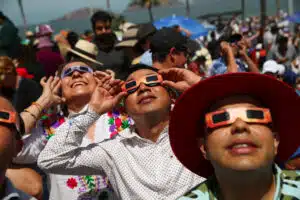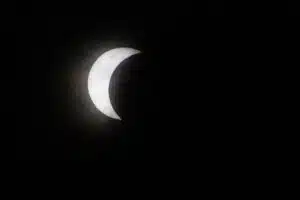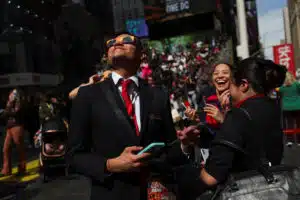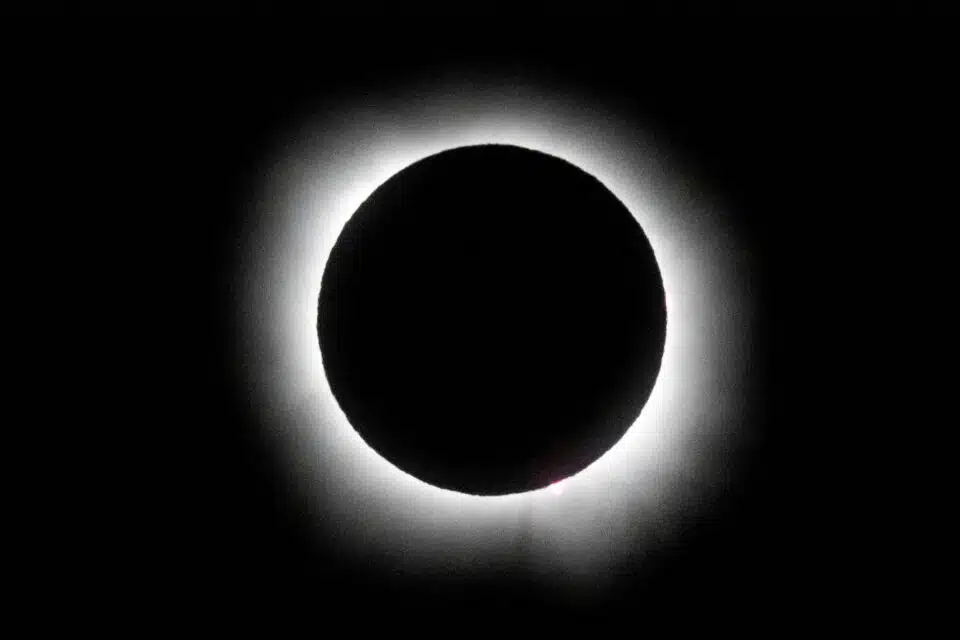NIAGARA FALLS, April 9 — Throngs of skywatchers across North America gazed upward at a blackened sun in the midday dusk yesterday, celebrating the first total solar eclipse to darken the continent in seven years with cheers, music, and matrimony.
From a Mexican beach resort close to where the eclipse made landfall to the banks of the Ohio River and farther north beyond the roaring cascades of Niagara Falls at the United States (US)-Canadian border, spellbound crowds reacted to the sight of ‘totality’ with jaw-dropping expressions of awe and joy.
In Russellville, Arkansas, a town of roughly 30,000 residents near the state’s only nuclear power plant, almost 400 couples tied the knot by the shadow of the moon in a mass wedding event dubbed ‘Elope and the Eclipse.’
At least two weddings and one marriage proposal were known to have taken place among roughly 2,000 people who assembled at Niagara Falls State Park despite overcast skies.
The dreary weather subdued the experience until clouds momentarily parted to reveal the last 30 seconds of totality, and the crowd went wild, cheering and shouting, “It is so beautiful!”
As the skies began to brighten again, a band played out the retreating lunar shadow with a rendition of R.E.M.’s 1992 hit song Man on the Moon.
Across the river in Niagara Falls, Ontario, 309 people — some from as far away as Singapore and London — came dressed up as the sun, setting a new world record for the largest group to wear solar costumes in one place, contest organisers said. The previous record was set in 2020 by 287 participants in China.

Shadows and light
Where clear skies prevailed, observers along the direct path of the eclipse were treated to the rare spectacle of the moon appearing as a dark orb creeping in front of the sun, briefly blocking out all but a brilliant halo of light, or corona, around, the sun’s outer edge.
It was the first total eclipse to sweep across a large swath of North America since 2017 and will be the last one visible from the contiguous United States until 2044.
As totality unfolded at a campground in North Hudson in upstate New York, hundreds of people shrieked with excitement.
“Oh my God!” some said, as the air cooled and automatic outdoor lights on a nearby building flicked on, fooled by the darkness.
Mexico’s beachside resort town of Mazatlan was the first major viewing spot for totality. Thousands in solar-safe eyewear perched in deck chairs along the coastal promenade, and an orchestra played the Star Wars movie theme as skies darkened under the approaching lunar shadow.
The crowds burst into cheers, applause and whistles when the eclipse reached totality.
The period of totality, lasting up to 4-1/2 minutes depending on the observer’s location, was ushered in by a number of other eerie eclipse effects. Some stars twinkled at midday as dusk abruptly descended, sending temperatures dipping and faint waves of “shadow bands” flickering over the landscape. Birds and other wildlife sometimes fall silent and still.
Eclipse fans travelled from far and wide, hoping to glimpse the phenomenon somewhere along the ‘path of totality’, stretching 4,000km from Mexico’s Pacific Coast through Texas and across 14 other US states into Canada. The moon’s shadow exited continental North America in Newfoundland.
A partial eclipse, in which the moon obscures only a portion of the sun, was visible across most of the continental US outside the path of totality, where weather permitted.
Lourdes Corro, 43, said she travelled 10 hours by car to reach Mazatlan, Mexico, for an event widely considered one of nature’s greatest wonders.
“The last one I saw was when I was nine years old. There are a few clouds but we can still see the sun,” she said.

‘Complete sensory experience’
Overcast skies across much of the US added an extra challenge for many.
Laura and Brian Uzzle awaited the eclipse on the banks of the Ohio River between Indiana and Kentucky yesterday after cloudy forecasts prompted the Denver-based couple to abandon initial plans to view it from Texas and book last-minute flights and rental cars several hundred km away.
Laura, 56, said she was excited to experience the eclipse by a riverbank teeming with birds and insects.
“Even the wildlife changes. It is a complete sensory experience,” she said.
The surge in eclipse enthusiasts taking to roadways in Indiana prompted the state police to announce it was shutting down highway rest stops once they reached capacity and kept them closed for the duration.
At up to four minutes and 28 seconds, yesterday’s total eclipse surpassed the duration of the 2017 event, which lasted upwards of two minutes and 42 seconds. According to the US’ National Aeronautics and Space Administration, solar eclipse totalities can range from 10 seconds to about 7-1/2 minutes.
The total eclipse rolled through more densely populated regions than seven years ago, a corridor averaging 185km wide encompassing major cities like San Antonio, Austin, and Dallas in Texas; Indianapolis in Indiana, Cleveland in Ohio, Erie in Pennsylvania, and Montreal in Quebec.
About 32 million people in the US live within the path of totality, with federal officials having predicted another five million people would travel to be there.
It took about 80 minutes from the moment the moon first began to cover the sun to the moment of totality, then another 80 minutes to complete the process in reverse.
The last remaining bit of brilliant sunlight before totality creates a ‘diamond ring effect,’ with a single bright spot glaring from one side of the lunar shadow while the sun’s corona still encircles the rest of the moon.
Some suggested the experience might have a lingering effect on human social behaviour, if only temporarily.
In Burlington, Vermont, where hotels were booked months in advance, Mayor Emma Mulvaney-Stanak said the thousands of visitors who gathered in her city exuded the mood of a midsummer festival.
“It was a really chill vibe. People were appreciating the momentousness of the occasion,” she told the press afterwards.
Asked if she believed the communal experience might help heal some of society’s festering political and social divisions, Mulvaney-Stanak said: “I really think it will.”
“Truly, this felt like another huge surge of optimism,” she said.
— Reuters






